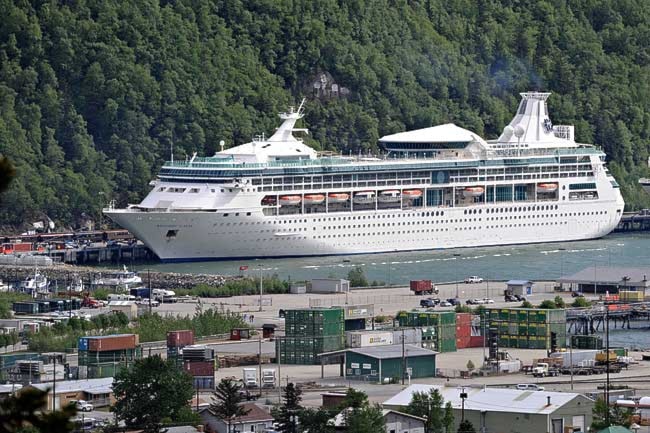Welcome to North America.
That may become the new greeting at both American and Canadian seaports and airports.
Prime Minister Stephen Harper and President Barack Obama agreed on Wednesday to beef up the single border encircling both countries, while reversing some of the security put inside the continent after 9-11.
The changes aim to block criminals and terrorists at the continent’s perimeter while shortening waits at the Canada-U.S. border.
Standards and regulations for main trading industries, like the auto sector, agriculture and health-care products, will become more compatible - if not exactly the same.
There will also be a single, electronic “window” for companies to give governments all the information they need to clear cargo.
Most security and intelligence work will be a joint effort, including a new system to track when people enter and exit each country.
And both nations will work together to improve and share border technology, infrastructure and information.
“Billions of dollars worth of goods and hundreds of thousands of people cross our shared border every day,” said Harper in Wednesday’s release. “Together, these agreements represent the most significant step forward in Canada-U.S. co-operation since the North American Free Trade Agreement.”
Buckwheat Donahue remembers when NAFTA was signed.
Governments promised it would be easier for goods and people to pass between the two countries, but for regular people, it didn’t really do that much, the Skagwegian said, noting that duties, taxes and restrictions continue to hold back shopping trips in Yukon.
And the Alaskan port town’s tourism director isn’t quite convinced this new agreement will do much for regular folk either.
“I think they should’ve paid just a little bit more attention to the common person,” said Donahue. “It doesn’t seem to be addressed too much. There were vague commitments to improving the process but nothing was expressly defined, like it was for the commercial traffic.”
One thing that will affect everyday travellers is the promise to make flying between the two countries a little bit easier by cutting out duplicate baggage screening.
“Finally,” said Donahue. Flying through Vancouver and Whitehorse is a common travel route for Alaskans. “What a pain in the butt reclaiming my bags has been.
“I think it’s finally acknowledging and showing a little bit more respect for the Canadians and their ability to conduct business.”
But there has been very little, if any, official discussion focused on the Yukon-Alaska border.
Pretty much all of the agreement’s propaganda discusses the 49th Parallel.
“They kinda forgot,” said Donahue, laughing.
And perhaps that absentmindedness is justified, considering the bulk of the largest bilateral trade relationship in the world passes across the countries’ horizontal border, to the tune of approximately $1.2 million per minute.
But here in the North, the countries’ vertical border may be getting busier.
Skagway has put in its bid to become the port of preference for developing mines in the territory, said Donahue.
Especially considering the industry’s connections with China, an easier border crossing between Yukon and Alaska could be the perfect little push needed to finalize the arrangement.
“It could mean 40 to 50 more trucks a day, adding to the existing traffic flow,” said Donahue. “It’s a trade-off. It could mean 25-30 jobs here in Skagway - which is huge for us. But it could mean a little bit more inconvenience on the highway.”
Quicker crossings from Skagway to Canada would be welcome, said Donahue.
“One of our problems with the border, on the U.S. side, is that sometimes it just takes so friggin’ long,” he said. “There are times when it appears that the border is simply understaffed and there might be 10 to 15 cars in front of you and it will take a half an hour to an hour to get in. And that’s way too long.”
Easier flow between Yukon and Alaska could mean more northern relationships will flourish, as opposed to the more geographically challenging, national ones.
It’s a hope, said Donahue.
“We could use this to our advantage to promote trade between the Yukon, Skagway and Haines,” he said. “Let’s do it! We live here in the North for a reason. And I would sure love to see Skagway as a thriving community on a year-round basis, not just for five months out of the year. If this agreement is going to help foster more of that - you betchya, babyshakes!”
A year ago, when leaks about Obama and Harper’s discussions on this deal were released in Ottawa, the Tourism Industry Association of Yukon welcomed the “potential European-style security perimeter in North America.”
Between 75 and 80 per cent of the Yukon’s annual visitors come from the U.S. said Krista Prochazka, executive director of the association.
“TIA Yukon supports, in principle, efforts that balance security with efficient border crossings for our visitors,” she said.
And on the other side of the vertical line, Donahue is happy to see any intentions of better co-operation.
“A lot of it is up to the individual at the border,” he said. “Let’s just hope that the folks on the U.S. side of the border take the new tasks to heart.”
Pilot projects, testing out some of the new ideas in the agreement, are expected to start in April 2012.
Both Obama and Harper have committed to annual reports on what is working, and what is not.
Donahue is also willing to report back in a year’s time.
“Call me back in a year,” said Donahue. “Then let’s review what they said, what they’re going to do and what the reality of the situation is.
“Hope springs eternal, that’s all I can say,” he said. “I can’t say that it will help, or that it will detract. But it can’t hurt - can it?”
Contact Roxanne Stasyszyn at
roxannes@yukon-news.com
